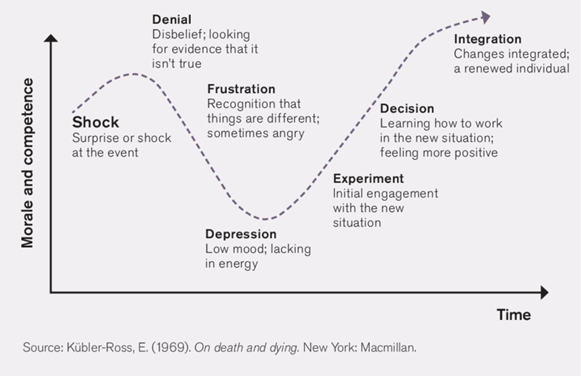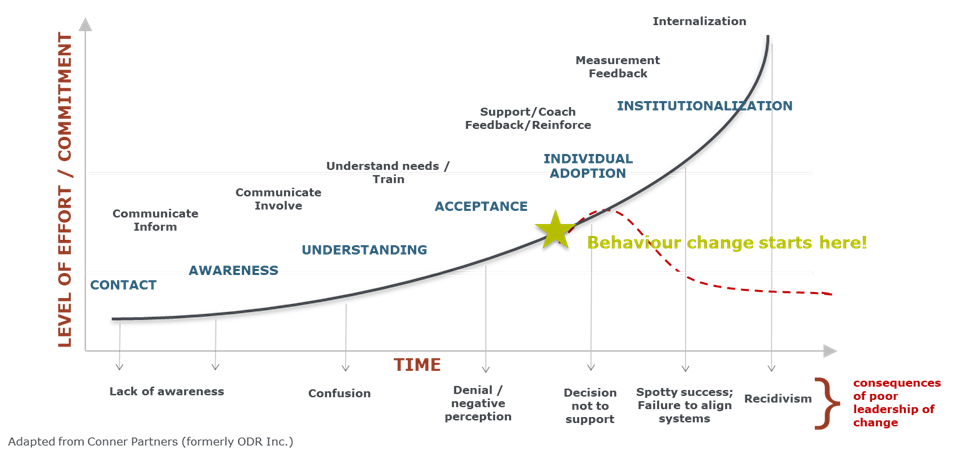What can we do when the change is announced?
Using a change leadership mindset, there are a number of behaviours and activities we can do to increase the chances of success for our change. For example, it’s often helpful to:
- Show more presence in our workplace, talking with people (moving towards the tension, not away from it)
- Continuously engage people on the current public service environment and their thoughts about what the range of potential impacts of the change might be
- Courageously invite discussion on difficult topics, as this will increase trust and reduce fear and uncertainty
- Connect people to some of the public service-driven change trends that are happening anyway, despite our preferences or concerns. For example:
- The need for all public service organizations to be more efficient
- The need for a focus on finding solutions to combat climate change
- The need to modernize service delivery
- The new technological and cultural landscape (e.g., the increasing shift to digital services, which were accelerated by COVID-19)
- Reinforce some of the higher order values that make the organization what it is to the public service and Canadians
- Help people remember significant changes they successfully went through in the past and what made it successful for them
- Be clear on what isn’t changing so that people have more certainty, an anchor to hold onto and can better discern what is actually changing
- Keep our understanding of the system and its interdependencies in our minds as we navigate the change (for more on this, see Section 3: Understanding our context / Determining where our change fits / Systems Thinking of the framework)
- Approach the change with a growth mindset, seeing it as an opportunity to grow and experiment professionally (for more on this, see Carol Dweck)
Using a change leadership approach and mindset can help us remain cognizant of the various elements of our change. Another key aspect is to support others to do so as well.
How can we encourage leaders to support implementation?
While we have been building manager/supervisor capacity in change leadership, there are a number of things we can remind managers of to encourage them to participate fully and positively in the change.
Changing (or “transition” as coined by William Bridges) is the difficult emotional work people have to do inside themselves to move along with the change. We all go through the various stages of transition at different times and at different speeds.
Based on work by psychiatrist Elisabeth Kubler-Ross (1969, On Death and Dying), we can think of this internal transition as a kind of grieving period. Individuals may or may not experience all of the stages of transition (noted below), and they may experience some more acutely than others. That being said, recognizing them better can help us understand why people may be supportive of the change or not.
The stages of transition are:
- Shock, confusion
- Denial
- Anger
- Bargaining
- Depression
- Testing
- Acceptance
The Change Curve

Leadership has a key role in recognizing and acknowledging these phases with staff, in understanding and validating the real losses people experience when a change is proposed, and generally in helping people through the transition. A good resource on transitions is Managing Transitions by William Bridges.
Some of the ways we can support this transition is to (adapted from William Bridges, Managing Transitions):
- Identify who is losing what – depending on the complexity of the change we may want to add a column to our stakeholder list identifying what, if anything, they may be losing or gaining
- Accept the reality and importance of subjective losses
- Expect “overreaction”, rather than being surprised by it
- Acknowledge losses openly and sympathetically
- Expect and accept that people are going through these phases of transition
- Compensate people for their losses
- Define what is over and what isn’t
- Mark endings
- Treat the past with respect
- Let people take a piece of the old way with them
- Show how endings ensure continuity of what really matters
Ultimately, we want to be aware that people will be going through a period of transition, at different speeds. Using this knowledge can help us better guide people through the change and result in better outcomes. One of the ways managers can do so is being consistently available and open to staff when they need to talk.
Change adoption

The adoption curve shows the progression in levels of adoption of the change (the labels in blue just above the curve), including some of the activities needed to support people through this progression located above each blue label.
The consequences indicated at the bottom of the graph show potential reactions when those activities are not (or are poorly) conducted. A key element here is where the star is positioned, which is at the first signal of acceptance.
A common mistake here is to assume that, because there is some adoption/behaviour change at this early stage, that the change is ready to take root. Rather, at this point we are just reaching a crucial tipping point. If we do not follow through on our actions in a sustainable manner the change is likely fail.
We still need to get as many individuals and groups as possible to adopt the change, with the aim to institutionalize it after our sustainability activities and reinforcement efforts (see Section 6: Developing our plans / Reinforcement/sustainability plan).
Next steps
As we move through implementation, we can prepare our feedback mechanisms in order to ensure we are as cognizant as possible of the various elements of our change. This is part of fostering dialogue, which will help us keep our finger on the pulse and allow us to adjust our plans and actions as appropriate. That’s what we’ll do next.